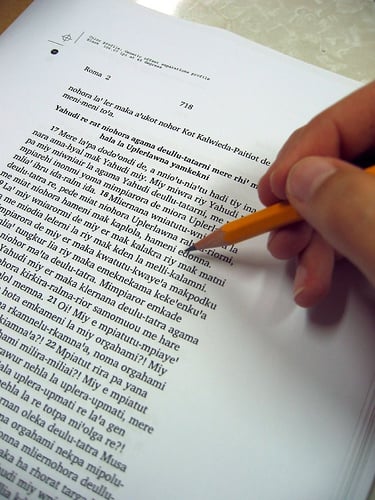Test Tip Tuesdays: Annotating the Reading Sections of the ACT and SAT

Most students are aware that marking and annotating ACT or SAT reading passages can be a powerful way to help manage their time, maximize their retention, and ultimately improve their reading scores. Nonetheless, I have often found myself sitting across from students, only to see their test booklet as pristine as it was when it first rolled off the copy machine. When pressed with the question as to why they chose not to make any notes, most students usually respond with one of two statements: “I didn’t know what to underline or annotate” or “Those things take too much time”. In my experience, both of these sentiments are most often the result of students having a misunderstanding of how to employ such tactics and a lack of practice with them.
Find the Sweet Spot
One of the first steps I take when reviewing annotation strategies with students is to have them read and annotate a sample passage on their own; the results show that relatively few students have a strong grasp on how much they should be taking note of. Most students naturally tend to over-annotate on their first attempt, underlining full paragraphs of text or occasionally writing short summaries of each paragraph, but there are also many students who under-annotate during this exercise. The key is to find the sweet spot between these two extremes. The goal of annotating ACT or SAT reading passages should be to highlight the most important aspects of the passage so that they can be referenced quickly while answering the questions without having to re-read large chunks of text. With such a goal in mind, the disadvantages of over-annotating are clear -- the more annotations a student makes, the more annotations they must review and consider for each question -- but under-annotating can be just as detrimental: if students fail to note key aspects from the passage in order to finish reading more quickly, they will often find themselves needing to reread large portions of text in search of answers to later questions.
Keep Notes Simple
As someone who spent a great many of his college years marking up the pages of classic literary works, elaborating upon authors’ every word, I fully understand the instinct to take copious notes, especially on more densely worded passages. However, the key to making effective annotations on ACT and SAT passages is that less is often more. In essence, the ACT and SAT are open book tests, so any notes students take while reading need only provide enough context to remind the reader what a given portion of the passage was about; if further information is needed to answer a question, students can use their notes as a reference point to help locate relevant information within the passage and limit how much they must re-read to a small section of the text. While taking notes in the margins about the author’s word choice and drawing connections to the world outside of the passage will almost certainly help with students’ long term retention and understanding of a work, within the confines of the ACT or SAT, it is more likely to yield little short term benefit on a timed test which focuses primarily on basic reading comprehension skills.
Know What to Look for
How can students tell which information is “important” within a passage? Ultimately, the “perfect” answer is through practice and trial and error - the ACT and SAT are standardized tests, which makes them predictable in their structure and the types of questions students can expect to see. With enough experience, students can come to predict which portions are most likely to be referenced in particular question types, despite the fact that the content will differ from test to test. However, to simply answer such a question by telling students to practice more would not make for a very strong “tip”, so here are some of the things that students can begin noting on the reading passages which are all but guaranteed to yield positive results:
- Main Ideas - Main ideas, whether those be the thesis of the passage as a whole or simply the topic of each body paragraph, are often the focal point of a large cross-section of different question types. Further, even if a question does not directly concern a main idea, students can use those main ideas to navigate the passage to find details as quickly as possible.
- Transitions - Transitions are used in order to link ideas together and, therefore, can be used to quickly establish a relationship between different ideas in a passage. I always encourage students to pay special attention to transitions signaling contrast as they can completely change one’s interpretation of a paragraph. Take, for example, my paragraph under “Know What to Look for” - it begins by stating that students should simply practice more to become more adept at annotating passages, but the word “however” in the fourth sentence changes the focus from generalized practice to a specific list of things students can look for. Additionally, students should be studying transitional words and phrases to improve on the English or Writing and Language sections of these exams as well; this means that students can use their experience with these words on those sections to provide context to their use on the Reading sections and vice versa.
- Questions - Authors rarely ask questions in a passage without reason, which, in turn, means that when they do, it is often to raise an important point. In many cases, the questions will be followed by an answer (i.e. When I began the aforementioned paragraph with “How can students tell which information is important within a passage?), or questions might be used rhetorically to emphasize one of the authors primary points - otherwise, what good is asking a question of a reader who cannot respond?
As with most reading strategies, learning to make effective annotations on Reading passages can be a frustrating practice at first, but over time it can become second nature. By building the skills to locate and isolate the most relevant portions of a passage, students, in turn, become stronger and more efficient readers, leading to more efficient time management on the test, higher test scores, and more confidence in their overall reading skills.


